Social Media Metrics to Track for Success in 2026
Table of contents
Social media gives us more data than ever, but not always the clarity we need. Every post, Story, or TikTok generates a new stream of metrics, yet 53% of marketers still struggle to tie their content to real business outcomes. So even with overflowing dashboards, meaningful insights can feel frustratingly out of reach.
Let’s change that!
In this guide, I’ll break down the key social media metrics, explain why they matter, and show you how to measure them in a way that supports your business.
What are social media metrics?
Social media metrics are the measurable data points (likes, shares, clicks, reach, mentions, sentiment, audience growth, etc.) that track how your content and channels perform. They act as scorecards for your social-media activity, telling you what’s working, what’s not, and where you can improve.
Why are social media metrics important?
Because without them, you’re blind: they show you how your social efforts contribute to real business goals (brand health, awareness, engagement, conversions), help you optimise your strategy, justify investment, and benchmark your performance versus competitors. Social media metrics are essential for measuring and optimizing your brand’s online presence.
How do you track social media metrics effectively?
They can be measured using a social media analytics tool and can include a wide range of information, such as engagement, reach, impressions, click-through rates, conversion rates, follower growth, and more.
What are social media metrics?
Simply said: They’re the numbers that show what your posts and profiles are doing.
- Reach tells you how many people saw you
- Engagement shows who liked, commented, or shared
- Click-throughs show who wanted more
- Conversions show who took action (like signing up or buying)
But these numbers only matter when they connect to your bigger business goals, whether that’s building brand awareness, generating leads, or driving sales.
When your metrics line up with what your business is trying to achieve, they stop being “just data” and start becoming proof that your strategy is working or guidance on what to do next.
The term itself is pretty broad – it covers many different types of measurements that can be grouped into categories depending on what you’re tracking.
These include:
- Social media marketing metrics
- Social media engagement metrics
- Conversion metrics
- Customer service metrics
- ROI metrics
- Other general metrics (that reflect overall performance)
With that covered, let’s move on to a more detailed part of this guide.
Below, you can find the key metrics to track from each category.
Ready? Let’s dive in!
Social media marketing metrics:
01 Social media reach
Why is reach an important metric?
Social media reach can tell you how many people have seen posts on your social channels and how the content spreads across social media.
It’s an effective way to measure how well your content resonates with your audience.
Tracking how it changes over time allows you to understand what kind of content works best for your particular audience. This way, you can adjust accordingly.
Moreover, reach indicates the size of your desired audience. You can assume that followers are interested in your message and, possibly, in the product.
The higher your reach, the bigger the audience that sees your product.
How to measure reach?
You can use a monitoring tool (for example, Brand24) to measure the reach of all platforms or individual sources.
Just set up a media monitoring project for your brand or campaign and get the insights.
Here’s the social media reach for Facebook, Instagram, TikTok, and Twitter over time:
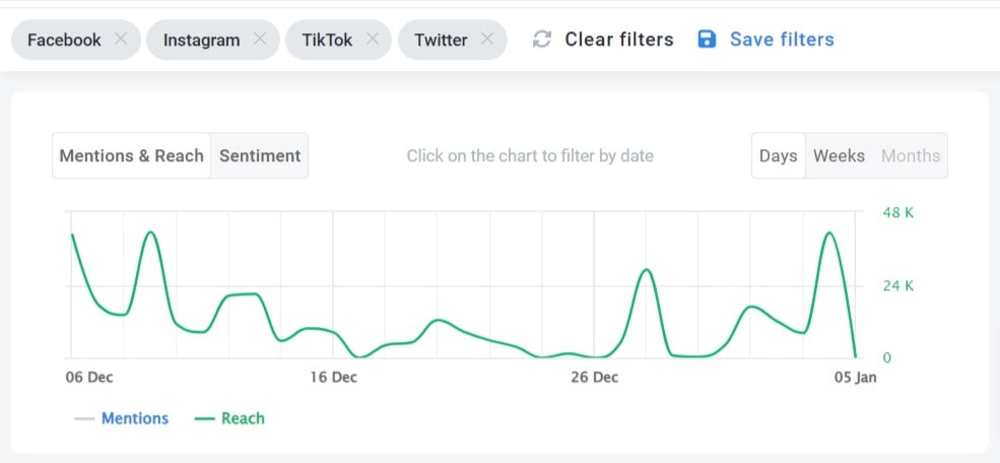
02 Social media impressions
In a nutshell, impressions are the number of times a social media post, ad, or other content is displayed to users on a given platform. This is different from reach, which is the number of people who actually see the content.
So why is it important to track impressions?
Tracking this metric can help marketers better understand how their content is performing and how it resonates with their target audience.
If your impressions are consistently getting higher, that’s a sign that your content is resonating with your followers and reaching new people. On the other hand, if impressions are decreasing, it may be time to adjust your content strategy.
It can also help you identify trends and compare the performance of different pieces of content. And that’s invaluable data for any marketer who wants to track social media efforts.
How to measure impressions?
Fortunately, most social media platforms allow you to see impressions for each post. For example, you can check the Impressions tab on Twitter under your post analytics:
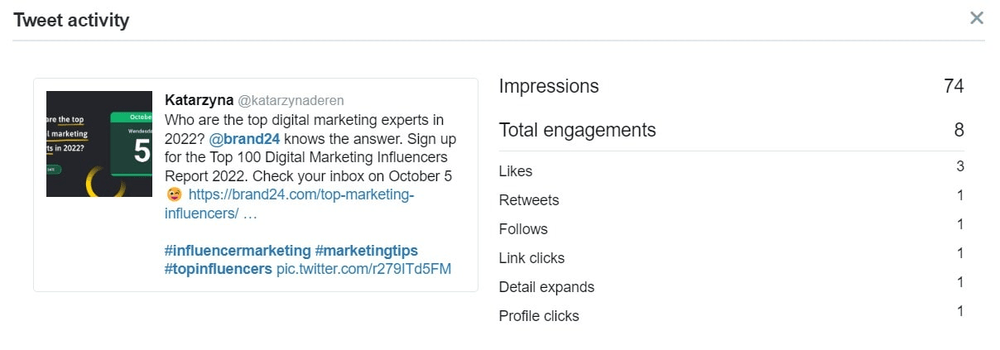
03 Follower count
Follower count is kind of your first impression online. It’s the first thing everyone look at when viewing your profile and impacts whether you’re:
- Trustworthy
- Popular
- Influential
- Worth following
Plus, it gives you an idea of your reach and shows how many potential eyes are on your content.
How to measure follower count?
This one’s easy – most platforms literally display your follower count on your profile.
But don’t just stop at the number!
Check if you’re gaining or losing followers over time. If your content is popping off, your follower count should reflect that.
You can track your follower growth in the internal analytics of most apps. It allows you to connect the ups and downs to your actions.
For example, at the time of that spike, one of my TikToks went viral:
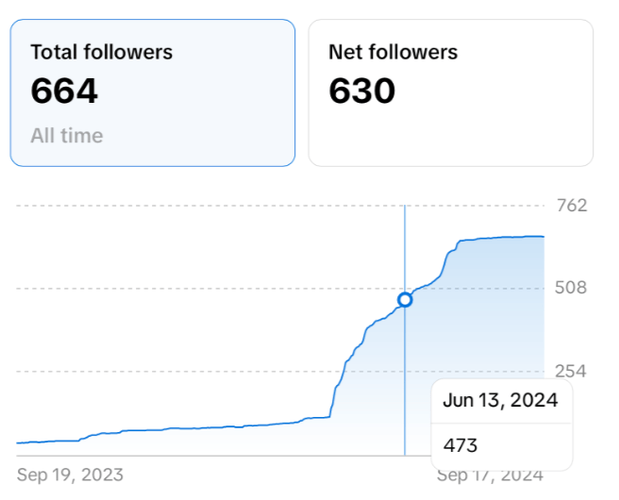
So… was that spike from your fire meme or that collab you did last week?
04 Audience growth rate
The audience growth rate measures the rate at which your audience grows over time.
A high growth rate indicates that your campaigns are effective, while a low growth rate indicates that you need to focus your social media efforts on different tactics.
It’s also a great way to track your progress and make adjustments as needed.
How to measure audience growth rate?
To calculate your audience growth rate, divide the number of new followers by the total number of followers and multiply the result by 100 to get the percentage value.
05 The volume of mentions
Analyzing social media data can help you understand customer behavior. How to do it?
By analyzing what people say about your brand.
The volume of mentions can tell you:
- How often people talk about your brand
- How do they feel about it
- If anything specific is making them feel that way
Why is tracking mentions important?
By keeping track of the number of your product or brand mentions, you can determine how significant your presence is and focus your social media strategy accordingly.
Tracking this metric also allows campaigns to be monitored in real-time and make improvements on messaging quickly if needed.
Pro tip: Measuring the volume of mentions from social channels helps spot any seasonal changes in interest.
Overall, tracking social media mentions is an incredibly useful way to:
- Measure the success of current marketing initiatives
- Detect new opportunities
- Ensure your content resonates with the right people
How to measure the volume of mentions?
You need to use a social media monitoring tool such as Brand24 to track brand mentions.
Set up a media monitoring project and start tracking your brand (or any other keywords) across social media, news, blogs, forums, review websites, newsletters, and podcasts.
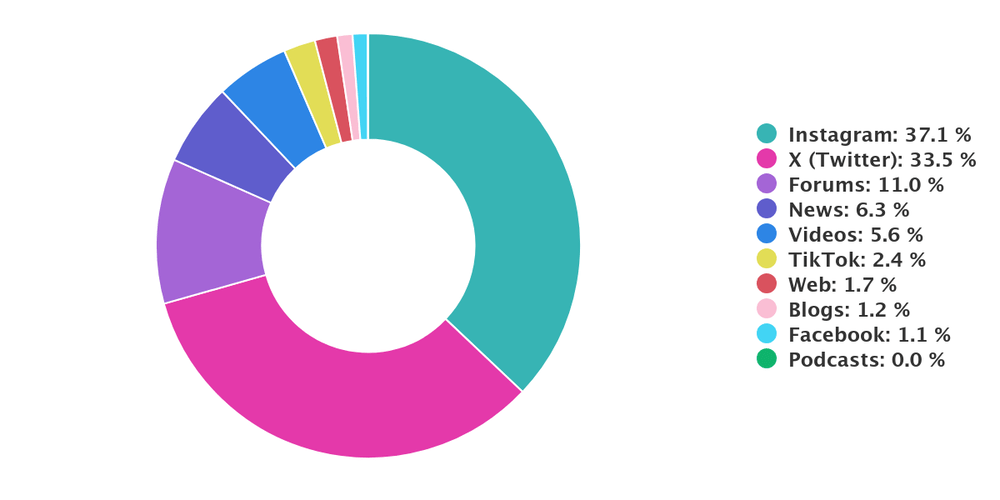
The volume of mentions and reach are social media metrics associated directly with brand awareness. Brand awareness will help you establish your company as a business leader within your niche.
Good brand awareness creates a level of trust between your customers and your brand. Furthermore, it helps to reach new audiences.
06 Audience demographics
Knowing who’s behind the screen is a game-changer. Demographics tell you things like your audience’s:
- Age
- Location
- Gender
- Interests
It’s like being able to peek behind the curtain and see who’s actually engaging with your content.
And it’s super valuable as it makes it easy to tailor your content accordingly.
How to check audience demographics?
Platforms like Instagram Insights and YouTube Analytics break down your audience demographics for you.
You can see who’s watching, where they’re from, and even what time they’re active.
This is what it looks like on Instagram:
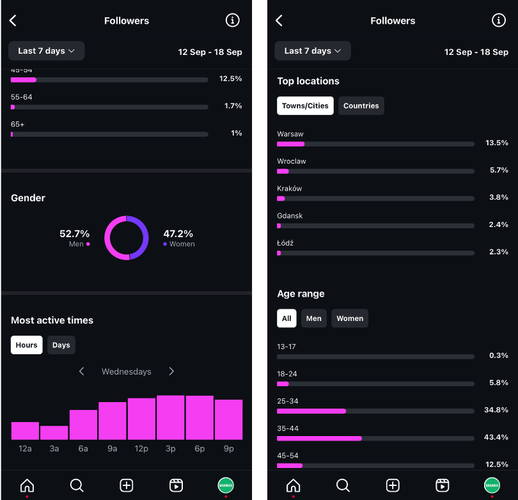
Personal pro tip: Look at your top-performing posts and see if certain groups (like people in a specific age range) engage more than others. This can help you tweak your content to better suit your core audience.
Social media engagement metrics:
07 Likes, shares, comments
Social media engagement metrics measure how much your audience interacts with your content and how often they like, comment, and share your posts.
Why does engagement matter on social media?
Because algorithms that decide which content to show first on a timeline consider your social media account’s number and type of interactions.
So, mentions, likes, clicks, shares, and comments are essential for a broad reach.
How to measure likes, shares, and comments?
To track your engagement metrics, you should keep an eye on the analytics dashboard inside the social media platform.
Here’s an example of how to find the analytics tab on TikTok:
- Go to your profile.
- Click the 3 stripes icon in the top right corner.
- Go to TikTok Studio > Analytics.
This is what it looks like:
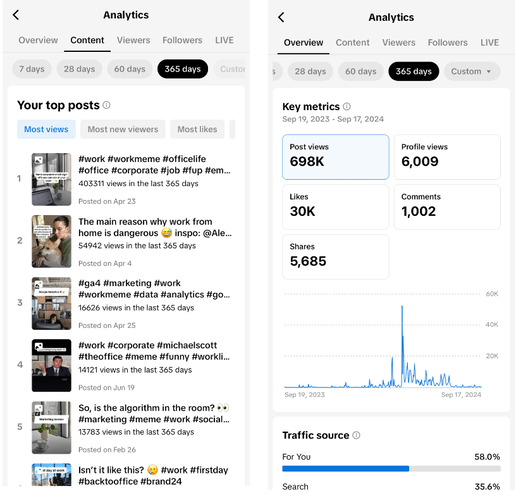
Also, you can monitor the overall number of comments, shares, and likes using a social media analytics tool.
08 Engagement rate
Why is engagement rate an important social media metric?
Simply said, it can tell you a lot about your performance.
It’s a measure of how much interaction your posts are getting relative to the number of followers you have.
A high engagement rate shows that your posts resonate with your audience, while a low engagement rate suggests you need to rethink your social media strategy.
One of the best ways to increase your brand engagement rate is by creating exciting and relevant content for your target audience. If you struggle to do it – think about your followers:
- What kind of content would they like to see?
- Who are these people?
- What is the language they use?
My observations tell me that organic mentions are an essential factor impacting engagement and reach. It’s worth monitoring brand mentions and interact.
Your followers will feel valued and trust you more. As a result, it will be much easier to build a community. Also, you can improve customer satisfaction by responding to client complaints.
How to measure engagement rate?
To measure your average engagement rate, divide the number of interactions by the number of followers, and multiply the result by 100 to get the percentage value.
09 Video views
According to the latest digital marketing trends, short-form videos will continue to be an important tool for businesses.
Video marketing is highly shareable, making it easier to reach a wider audience. A lot of businesses have already adopted video content as a tool for marketing and communication.
That’s why it’s worth paying attention to video views. They indicate how many people have watched your videos.
This is an important metric to track because it gives you an idea of how engaging your videos are. The rule is simple:
The higher the view count, the better.
How to check video views?
I think every platform tracks this for you. But they count views differently.
“When is a view on my video counted?”
Instagram shows views once they hit 3 seconds, while YouTube counts a view at 30 seconds, and TikTok does so instantly.
10 Watch time
Watch time takes video views to the next level. It measures how long people actually stay to watch your video.
This metric is crucial because it shows if your content is just catching someone’s eye, or if it’s really holding their attention.
How to measure watch time?
It’s also a metric that platforms count for you. Just go to the analytics of your specific TikTok, Reel, or YouTube video, and voila!
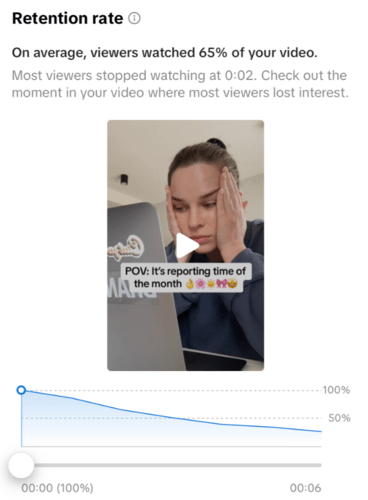
My pro tip: If your average watch time is low, maybe the intro isn’t grabbing enough attention, or the content slows down in the middle? The longer you keep people watching, the more chances of getting viral. In other words: watch time equals visibility!
11 Virality rate
This metric measures the rate at which users share and spread content on a social media platform.
A high virality rate indicates that many users share the content with friends and followers. This helps increase the reach and visibility of content.
Content that goes viral is generally more engaging and resonates with a larger audience. By tracking virality, marketers can understand what kind of content resonates with their audience and create more of that kind of content.
How to measure virality rate?
To measure your virality rate, divide the number of shares by the number of impressions and multiply the result by 100 to get the percentage value.
Conversion metrics:
12 Click-through rate (CTR)
What is CTR?
Click-through rate (CTR) is a metric that measures the number of clicks a post receives divided by the number of impressions. In other words, it measures how many users clicked links in social media posts.
A high CTR means your post is interesting and encourages the audience to click.
A low CTR, on the other hand, may indicate that your post is not resonating with your audience, and you should rewrite it.
CTR varies across different platforms. A post with a high CTR on one platform might perform differently on other channels. In addition, each post format can also have different CTR averages.
How to measure click-through rate?
To measure average CTR, divide the number of clicks by the number of impressions and multiply the result by 100 to get the percentage value.
13 Lead generation
In the world of social media marketing, it’s not just about getting likes and shares – it’s about driving meaningful actions that contribute to your business goals.
Lead generation is crucial for measuring the success of media campaigns. It tracks the number of users who complete a desired action, such as making a purchase, filling out a form, or subscribing to a newsletter.
For example, if someone subscribed to your product by clicking the link in a social media post – it’s a lead generated via social media.
How to measure lead generation efforts on socials?
To measure it, you can use tools like Google Analytics. Additionally, social media platforms like Facebook and Instagram offer built-in analytics to track conversions and leads generated from your ads and posts.
14 Top referring social media channels
This metric measures the number of people who come to your website from a social media channel. High referral traffic can indicate that social media is an effective way of driving website traffic.
By monitoring the top referring channels, you can discover which channels are relevant to your business. Plus, find new ones worth trying out.
How to check top social channels?
You can use various analytics tools to track your referral traffic.
Google Analytics offers a tool called Source/Medium, which allows you to track your website’s traffic sources.
You can use this data to identify the top referring social media channels.
Customer service metrics:
15 Response time
Response time is one of the most important customer service metrics.
It shows how quickly your brand reacts to customer questions, complaints, or mentions across social media.
A fast response time demonstrates that your brand is attentive, reliable, and values customer feedback.
On the other hand, delayed responses can frustrate users and negatively impact your brand’s reputation.
In today’s social media reality, users expect near-instant communication.
How to measure response time?
Some social media platforms display your average response time in the inbox or analytics tab.
You can also use social media monitoring tools to track when mentions appear and monitor how long it takes for your brand to respond.
Keeping your average response time low builds trust and increases customer satisfaction.
16 Customer satisfaction (CSAT)
What is CSAT?
Customer satisfaction (CSAT), measures how happy your customers are with your brand, products, or services.
It’s one of the most direct indicators of whether your social media efforts translate into positive customer experiences.
Tracking CSAT helps you understand what customers think about your support, communication, or overall brand experience.
High satisfaction scores mean your audience feels heard and valued, while low scores can highlight areas that need improvement.
How to measure customer satisfaction?
You can measure CSAT through quick surveys, feedback forms, or direct interactions on social media.
Many brands use simple rating scales (for example, “How satisfied are you with our support today?” from 1 to 5).
Additionally, you can analyze customer sentiment using social listening tools to identify positive, neutral, and negative mentions automatically.
Monitoring CSAT alongside sentiment gives a complete picture of customer experience.
17 Sentiment analysis
Sentiment analysis will tell you whether the talk around your brand (the volume of mentions) is:
- positive
- negative
- neutral
This social media metric is especially useful when you’re running social media marketing campaigns.
Initially, a high number of mentions might suggest that the campaign is successful. After all, people are talking about your brand.
But that’s not the whole picture.
A high volume of mentions and prevailing negative sentiment is asking for trouble. It means that a social media crisis is on its way, and you have to implement your crisis management plan into action.
How to measure sentiment?
You can detect the sentiment easily using a social media monitoring tool.
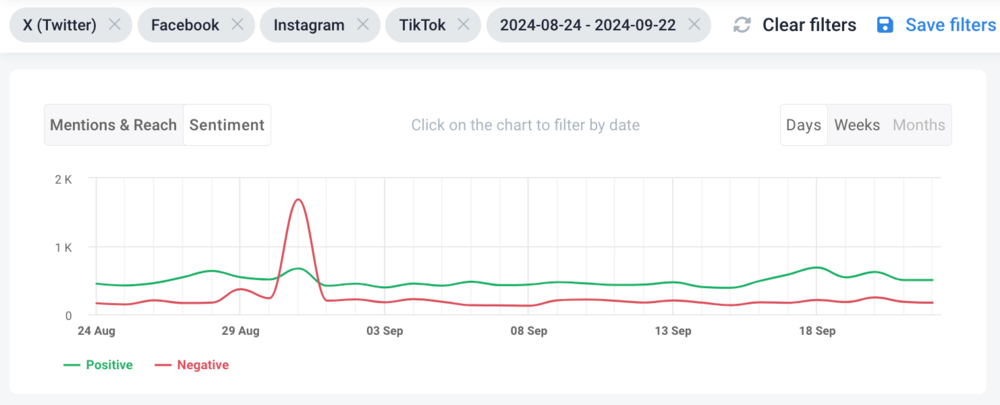
Also, a media monitoring tool will detect the sentiment of each mention.
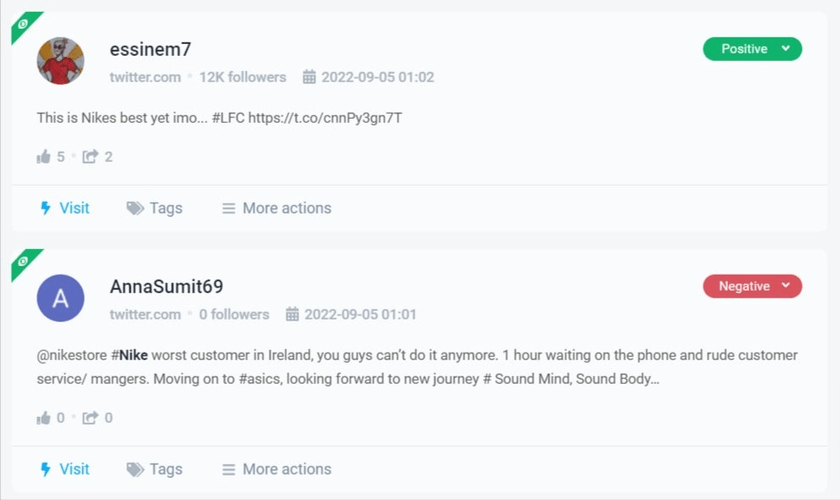
Plus, here’s a fun thing. AI technology can go even one step further and detect actual emotions behind those mentions:
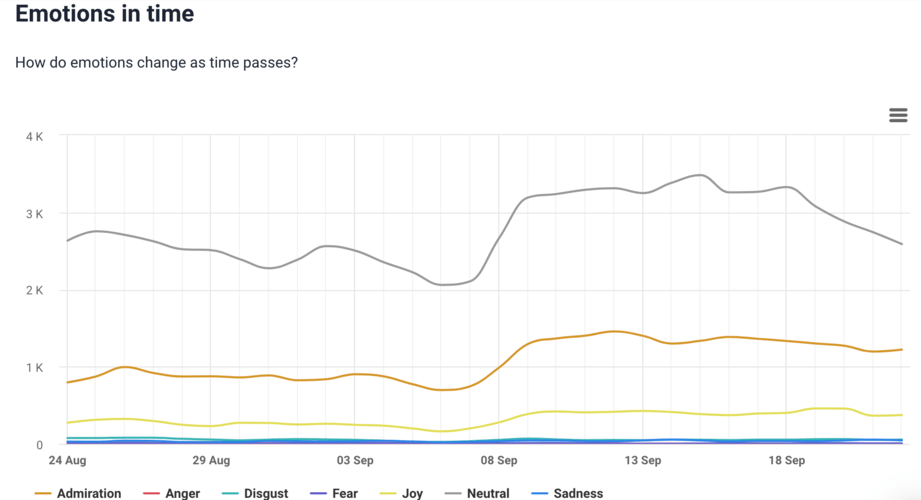
ROI metrics:
18 Cost-per-click (CPC)
Why measure CPC?
Marketers should measure Cost-per-click (CPC) to ensure that their campaigns are performing optimally and that their advertising budget is being used efficiently. By tracking CPC, you can identify which campaigns are performing the best.
This social media metric helps marketers evaluate their advertising campaigns’ return on investment (ROI) by providing information about each click’s cost.
How to measure cost per click?
To measure CPC, divide the total ad spend by the number of clicks and multiply the result by 100 to get the percentage value.
19 Return on ad spend (ROAS)
Return on Ad Spend (ROAS) is a key metric that shows how much revenue you earn for every dollar spent on advertising.
It’s one of the most telling indicators of how effective your paid social media campaigns are.
- A high ROAS means your ads are generating solid returns. They’re reaching the right audience, delivering the right message, and driving real actions.
- A low ROAS, on the other hand, signals that your campaigns may need optimization in targeting, creative, or budget allocation.
By tracking ROAS, you can clearly see which campaigns bring in the most value and which ones drain your budget.
It can help you allocate resources more efficiently and scale what’s working.
How to measure ROAS?
To calculate ROAS, divide the total revenue generated from your ads by the total amount spent on them.
ROAS = Revenue from ads / Ad spend
For example, if you earned $5,000 in revenue from a campaign that cost $1,000, your ROAS would be 5:1
Meaning you earned five dollars for every dollar spent.
20 Return on Investment (ROI)
Return on Investment (ROI) is the ultimate performance metric that measures the overall profitability of your social media activities.
It tells you whether the time, effort, and money you invest in social media marketing actually pay off.
- A positive ROI means your campaigns contribute real value to the business
- A negative ROI means it’s time to revisit your strategy.
How to measure ROI?
To calculate ROI, use this simple formula:
ROI = (Net profit from social media / Total social media investment) ×100
For example, if your social media efforts generated $10,000 in profit from a $4,000 investment, your ROI would be 150%.
21 Campaign success rate
Measuring the success rate of a media campaign involves tracking key metrics such as:
- Engagement rate
- Reach
- Conversions
- Return on ad spend
By analyzing these metrics, you can understand the effectiveness of your campaigns and optimize your strategy. This helps you figure out what hit and what missed.
How to measure campaign success rate?
Use social media analytics tools to gather data on your campaign’s performance.
Platforms like Meta Business Suite or TikTok Studio provide detailed reports on various social media metrics.
Additionally, tools like Google Analytics can help you track conversions and referral traffic from social media channels.
By regularly reviewing these metrics, you can identify areas for improvement and adjust your strategy to maximize the success of your campaigns.
The success rate of a campaign can be measured using several key performance indicators (KPIs) that align with your campaign goals. These can include metrics such as:
- Reach
- Impressions
- Engagement rate
- Click-through rate (CTR)
- Conversion rate
- ROI
Analyzing these KPIs provides valuable insights into the effectiveness of your social media marketing efforts and helps inform future strategies.
Social media success is often a combination of these metrics, indicating a well-rounded, effective social strategy.
Other general metrics:
22 Share of voice
Share of voice indicates what percentage of the whole discussion was generated by a social media account. The more people talk about your company online, the better your channels perform.
Combining this metric with social media sentiment analysis will tell you who is talking about your company and how they feel about it.
The share of voice is the creme de la creme of your social media analysis.
How influential is your profile? Are you able to spark discussion among your followers?
In other words, the share of voice metric will help determine whether you’re the industry leader or not.
How to check share of voice?
Media monitoring tools measure the share of voice of social media accounts. For example, Brand24 selects the public profiles and calculates the share of voice automatically.
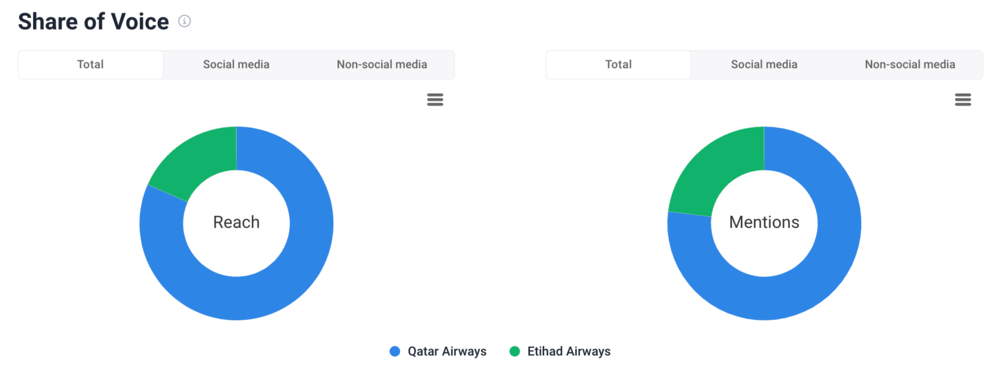
23 Presence Score
Are you aware of how popular your brand’s popularity on social media? No? Don’t worry.
The Presence Score metric allows checking the brand/topic online popularity in a given period. It helps to measure brand awareness and evaluate marketing and PR efforts.
I personally like to use it as a quick check-up of the brand’s health.
Presence Score operates on a scale from 0 to 100, where 100 is achieved only by huge, globally recognized brands.
How to measure presence?
Go to the Brand24 dashboard. The tool automatically compares your results with the popularity of other brands/topics.

24 Hashtag usage
Hashtags can be more than just a way to boost visibility. They are a crucial metric for understanding your brand’s impact and reach.
If you have a branded hashtag, you can track how often it’s used across social media platforms.
This gives insight into how well your hashtag resonates with your audience, how much engagement it drives, and how your campaigns perform.
How to measure hashtag popularity?
The easiest way is to set up a media monitoring project for your hashtag.
With the help of social media monitoring tools, you can measure:
- The total number of mentions that include your branded hashtag.
- The social media platforms where the hashtag is most frequently used.
- The overall reach generated by your hashtag.
- The sentiment around your hashtag.
Take a look below. This is the analysis by Brand24 on how Asics’ #ASICSFrontRunner was used over the past 30 days:

What are the best social media metrics tools?
Tracking social media metrics can be done with various tools:
- Native analytics tools – each social media platform has its own set of native analytics tools for businesses or individuals using business accounts. These tools allow you to track metrics specific to that platform, such as engagement and reach on Facebook, Instagram, etc.
- Social media management tools – such as Hootsuite and Sprout Social, allow you to manage and track metrics for multiple social platforms in one place. They typically provide real-time data on engagement, followers, reach, and more.
- Analytics tools – such tools as Google Analytics focus primarily on analytics and reporting, allowing you to track the performance of your campaigns and get insights into the effectiveness of your content.
- Social media monitoring tools – like Brand24, allow you to track mentions of your brand across the web and social media. They can help you stay on top of customer sentiment and identify opportunities for engagement.
| Type of tool | Examples | Purpose | Metrics tracked |
|---|---|---|---|
| Native analytics tools | Meta Business Suite, TikTok Analytics, X Analytics | Track metrics within individual platforms | Engagement, reach, impressions, follower growth, audience demographics |
| Social media management tools | Hootsuite, Sprout Social, Buffer | Manage and track multiple social media accounts in one place | Real-time engagement data, follower growth, post scheduling, reach, performance comparison across platforms |
| Analytics tools | Google Analytics | Focus on reporting and data analysis | Traffic sources, conversion rates, referral data, campaign performance |
| Social media monitoring tools | Brand24, Mention, Talkwalker | Monitor brand mentions and sentiment across social media and the web | Mentions volume, sentiment analysis, share of voice, hashtag tracking, customer insights |
Understanding and analyzing social media metrics can be a complex and time-consuming task.
But don’t worry!
AI technology can significantly simplify this process.
Take a look at the “Summary” created by AI Brand Assistant that Brand24 provides in the tool.

This feature provides a comprehensive overview of your social media performance. It offers insights into metrics like:
- Reach
- Sentiment
- Sources
- Topics
And it is all without the need for manual calculation or interpretation.
Using AI, Brand24 ensures you have a clear, actionable understanding of how your content is performing and what steps you might take to enhance your social media strategy.
This feature makes staying on top of your social media metrics simple. You’re using your time effectively and can focus more on strategy and important decisions.
Conclusion
We can track dozens of social media metrics. But what really matters is to follow social media metrics related to your goals.
If you track your data consistently, you will have a ton of actionable insights that will help improve your social media presence. Also, tracking social media is the only way to improve and report ROI.
Information is power, and the more you know about your social media activities, the better decisions you can make.
Key takeaways:
- Measure your social media performance before any strategic moves.
- Use tools that simplify your work and not the other way around. Look for AI features and easy integration.
- Test your actions. It’s one of the best ways to develop strategies that actually work.
Use the above tips and combine them with an analysis and monitoring tool like Brand24. Here you can try it for free: Start trial!





